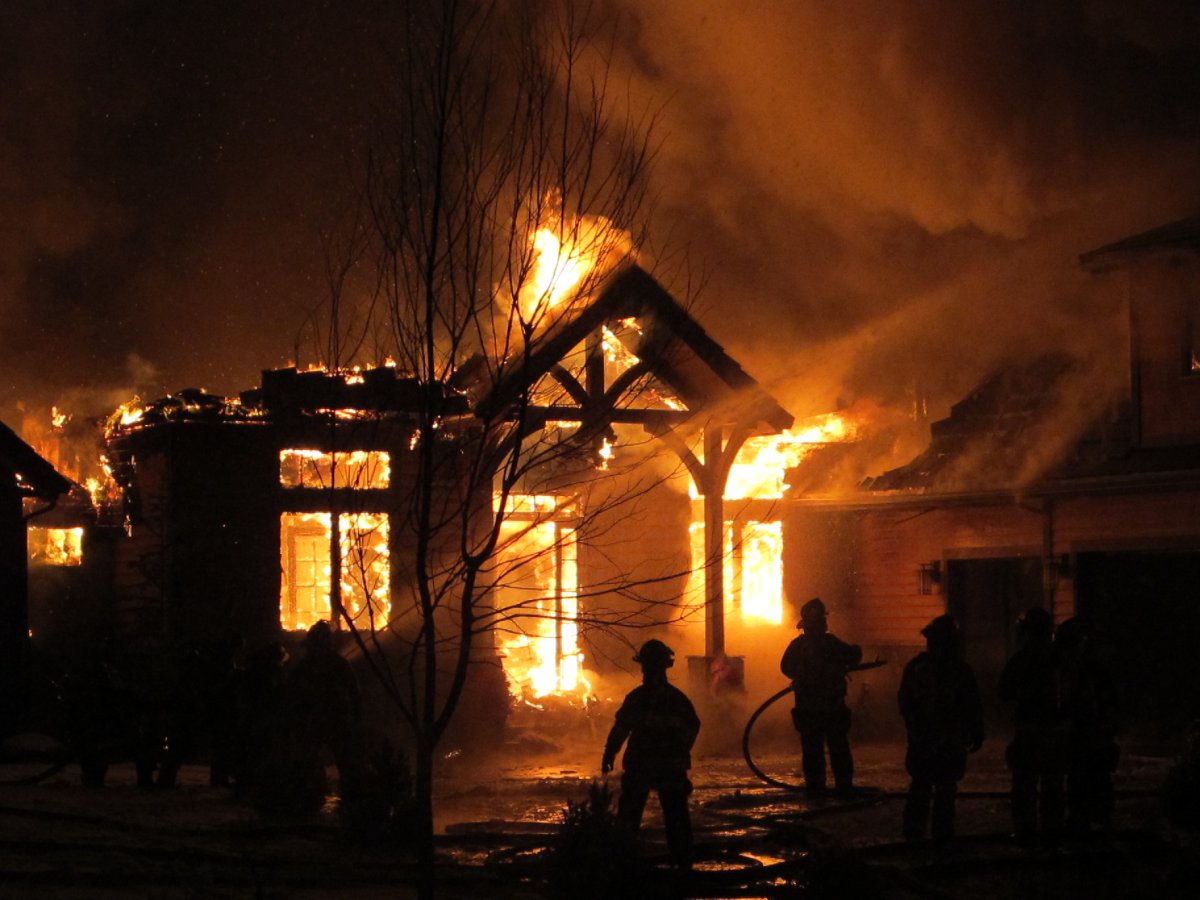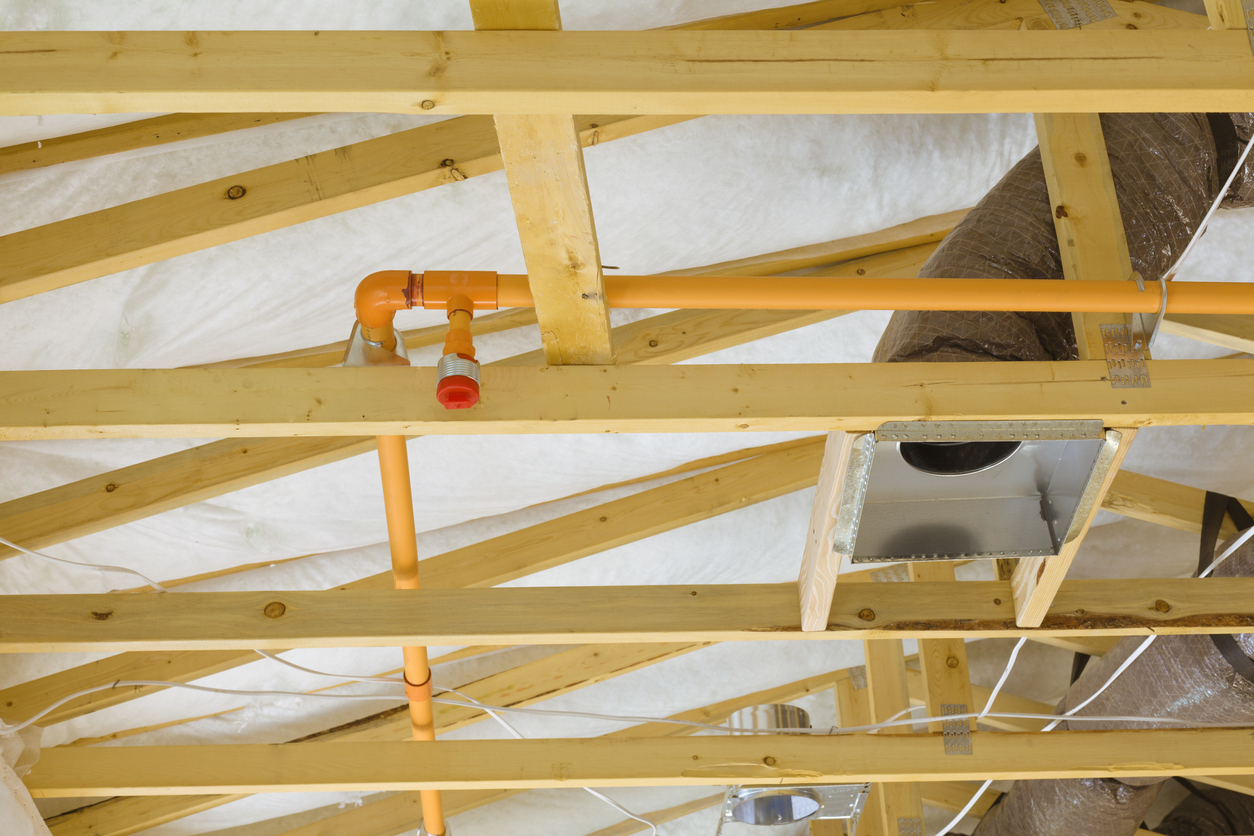

We may earn revenue from the products available on this page and participate in affiliate programs. Learn More ›
Eighty percent of fire deaths occur in residences, with over 3,000 people dying per year in U.S. house fires. Despite the statistics, home fire sprinklers have yet to become code-mandated in new-home construction, and few homeowners who have the option choose to include this life-saving investment in their home.
The Case for Fire Sprinkler Systems
Common misconceptions about sprinkler systems (also called residential fire-protection systems and residential fire-suppression systems) prevent people from including one in their home. The fear of a misfiring sprinkler head and the belief that a room fire activates the entire system are two such common misconceptions.
“Hollywood movies show sprinklers going off everywhere,” says Roy Marshall, executive director of the Residential Fire Safety Institute (RFSI). “This is what people think of, and it’s unfortunate.” In truth, occurrences of misfiring sprinkler heads are extremely rare (one manufacturer claims the chances to be 1 in 16 million), and systems are designed so only the sprinkler heads directly affected by the heat of a fire become activated, not the whole system.
A residential sprinkler system will save a homeowner money in the event of a fire. When activated, a sprinkler head will spray 15 to 20 gallons per minute. “Eighty to ninety percent of fires are put out with one sprinkler head,” Marshall says. Water damage from fire suppressed by a home sprinkler system incurs an average of $2,200 in costs; water damage from a fire suppressed by a fire department adds up to an average of $45,000. “The sprinkler head will put out the fire before it grows,” says Marshall, “while the fire department may take 15 to 20 minutes to get there, and when they do they are dumping 250 gallons per minute and chopping holes in the roof to put out the fire.”
In some states, residential sprinkler systems are now required by code in new construction and certain-sized remodels.
The Basics of Fire Sprinkler Systems
The sprinkler heads used in residential fire sprinkler systems will vary by manufacturer, but most are heat activated. Some feature a bulb filled with a special liquid that expands at a consistent rate when exposed to heat — at a designated temperature the bulb will break, activating the sprinkler head.
Other sprinkler heads might have a soldered link that melts at a certain temperature. One sprinkler is usually enough to provide coverage for an average size room. Larger rooms may require two. Residential sprinkler heads come in a variety of designs that range from the commercial-looking metal spoke head to sleek, décor-friendly discs.
Systems also typically include a flow alarm that sounds an alert when the system has been activated. An alarm bell installed on the outside of the house can alert neighbors to system activation if the homeowners are not present. Some systems can be designed to alert the local fire department in the case of activation, and others can tie into a home’s security system.
Stand-Alone vs. Multi-Use Sprinkler Systems
There are two main types of residential sprinkler systems: stand-alone and multi-use.
STAND-ALONE SYSTEMS
Although both systems rely on the home’s water supply, a stand-alone system utilizes its own piping, and may need a back-flow device. Stand-alone systems will use flexible plastic or copper tubing. If a home relies on a well for water, a storage tank and pump will be necessary to ensure an adequate water supply for the system in the event of a fire. Storage tank size may vary depending on system size, and some codes require a minimum-sized tank. (Scottsdale, Ariz., for example, requires a 550-gallon minimum storage tank for residential sprinkler systems running off a well.)
The water in stand-alone systems does not circulate, and might be susceptible to stagnation, depending on the piping used. “Our orange plastic tubing will not corrode or leave any sediment,” says Jack Wilkinson, vice president for Genesis Fire Protection Inc. “There is no maintenance required.”
MULTI-USE SYSTEMS
A multi-use sprinkler system shares the home’s plumbing pipes; every time water is run anywhere in the home, fresh water moves through the pipes. This type of system ensures that in the event of a fire, non-stagnant water will be released. Multi-use systems are installed during new-home construction, and are engineered specifically for the home. Additions or remodels that seek to expand upon a multi-use sprinkler system can be quite difficult.

Installation and Costs
The easiest way to install a home sprinkler system is during new construction, although retrofits are possible. Both types of systems can be stand-alone or multi-use and are usually installed by specialized installers. It is common to see contractors offering both fire safety and security installations and services. In some areas, a plumbing contractor may install the system.
Installation time will vary depending on the size and nature of the project. In a retrofit, installers might use the home’s plans or measure up the building to draw up a system plan, do an estimate, and write up a proposal for the homeowner to sign off on. Once a system is designed, a permitting process may apply. “It takes about 30 to 45 days for the permit,” says Wilkinson, who adds that a two-story, 3,000-square-foot installation might take a week to ten days to complete, depending on variables like open trusses, solid joists, attic and crawl spaces.
The cost of a home-sprinkler system will depend on a number of factors. A new-home, stand-alone installation can run anywhere from $1.00 to $1.25 per square foot, while a retrofit could cost $5 to $6 per square foot. The RFSI has its own calculation, estimating the cost of a system to be about “1 to 1.5 percent of the cost of the home,” says Marshall. Additionally, insurance companies can offer discounts to homes with fire-suppression systems. These discounts can range from 5 to 15 percent.
